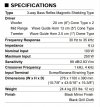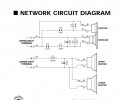Purplehazeffc
Member
- Joined
- Feb 25, 2023
- Messages
- 5
- Likes
- 1
Hello All..
I would like to upgrade/change the crossovers in my Yamaha NS-777 tower speakers.
With dual 8″ woofers, 5″ mid, 1′ tweeter. I find the crossover values could be improved. The current values are 1000hz – 4000hz which I find for 8″ woofer, 1000hz a bit to high. I played just through the 8″ woofers & way to much vocals are coming through. Personally I think they should be crossed over at the 500hz with the 5″ mid easily playing the 500hz – 4000hz
As I'm coming from car audio where in a 3 way front stage it's crossed over at 400hz & 3000hz. Also the majority of new 3 way speakers are the same.
As their factory crossover has just coils & caps, without any resistors etc. Is it viable just to do the same with a new designed crossover? I have included the diagram of the factory crossover & the specs of the speaker. Is changing the crossover a viable thing to try?? As it would be way cheaper than possible buying new speakers.
Thoughts?? And how best to design a new crossover??
Cheers
I would like to upgrade/change the crossovers in my Yamaha NS-777 tower speakers.
With dual 8″ woofers, 5″ mid, 1′ tweeter. I find the crossover values could be improved. The current values are 1000hz – 4000hz which I find for 8″ woofer, 1000hz a bit to high. I played just through the 8″ woofers & way to much vocals are coming through. Personally I think they should be crossed over at the 500hz with the 5″ mid easily playing the 500hz – 4000hz
As I'm coming from car audio where in a 3 way front stage it's crossed over at 400hz & 3000hz. Also the majority of new 3 way speakers are the same.
As their factory crossover has just coils & caps, without any resistors etc. Is it viable just to do the same with a new designed crossover? I have included the diagram of the factory crossover & the specs of the speaker. Is changing the crossover a viable thing to try?? As it would be way cheaper than possible buying new speakers.
Thoughts?? And how best to design a new crossover??
Cheers





